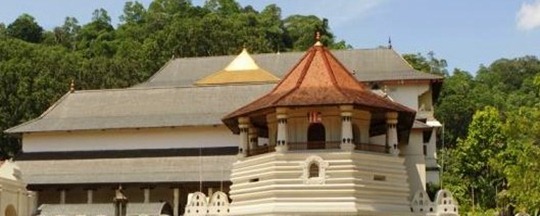Kandy, the last royal capital of Sri Lanka is a major tourist destination. ( 115kM from Colombo at 465 meters above sea level). Famous for the Temple of the Tooth and many other temples the city could be called the cultural capital of the island.
Kandy Perahera, the pageant of the temple of tooth where Buddha's tooth is kept is held either in July or August each year to parade the golden caskets is a must see itenary if one is visiting Sri Lanka during these months. The final night procession is the most spectacular event of the country. More than 50 elephants parade the city accompanied by the drummers, dancers and chieftains.
he city established in the 15th century was the last royal capital where 2500 years of royal rule ended. This bustling market town is rich in cultural diversity has plenty of iteneries to offer to the tourists from songs dances and handy crafts to ancient temples and adventure activities. Kandy is a good transit point to the cultural triangle to the north or hill country to the south. The city is also a good source of souvenirs or to experience many cultural performances at it's various hotels in the city.
The Temple of Tooth
Adjacent to the Temple of the tooth are three of the four major Hindu shrines taking part in the Kandy Perahera. Shrines are dedicated to Gods Vishnu and Natha and Goddess Patthini. The forth shrine is further towards the town. Visitors to these shrines could witness the Hindu religion customs though most of the worshipers today are Buddhists. Hindu shrines taking part in the Buddhist pageant is a good example of the Sinhala and Tamil co-existence that lasted for centuries. Four of the last Sri Lankan kings were of south Indian origin.
Lankatilaka Temple
Gadaladeniya Temple
Embekke Temples
The Royal Botanical Gardens
Kandyan Dancing
 The Kandyan dance has become most distinctively Sinhalese and is readily associated with the idea of a National Dance. This development can be explained by the fact that the Kandyan Kingdom was the last of the Sinhala kingdoms to fall under foreign rule (1815). Whilst elsewhere in the Island the Dance sank into indifference encouraged by neglect or began to manifest sympto
The Kandyan dance has become most distinctively Sinhalese and is readily associated with the idea of a National Dance. This development can be explained by the fact that the Kandyan Kingdom was the last of the Sinhala kingdoms to fall under foreign rule (1815). Whilst elsewhere in the Island the Dance sank into indifference encouraged by neglect or began to manifest sympto
ms of corrupt form and body, in the Kandyan kingdom, the Dance flourished under Royal patronage and, like other crafts, was cared for with great interest. The systematization of the dance forms was possible and the oral tradition had time to spread amongst the villages. The Dance, apart from being kept alive, also maintained a purity which gives it its unique quality. This same purity, however, did not make the Dance an adequate vehicle for theatrical modes of presentation, confrontation and entertainment.
One might also observe that the religious organization and institutionalization of the clergy and their code of conduct prohibits the encouragement of or indulgence in Nacca (dance), Gita (song) and Vadita (music). This same discipline was encouraged amongst the pious laity too. Thus Buddhism remains the religion amongst the great religions that does not encourage either dance or music. In this way the Dance developed away from the devotional system of, for instance, the Indian Bharata Natyam. However, the close link maintained between the Court and the Clergy (the Sangha) made it inevitable that the Sangha should indirectly condone the encouragement of the Dance by the kings. The Sinhalese tradition was thrown back onto a social factor prior to its Buddhist conscience but developed with it, through it, around it and also by-passed it.
















0 comments :
Post a Comment